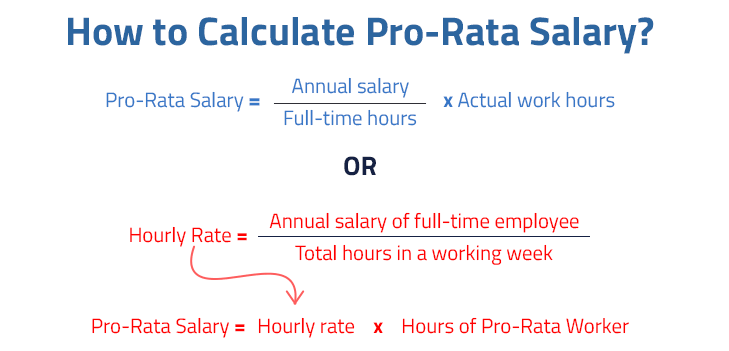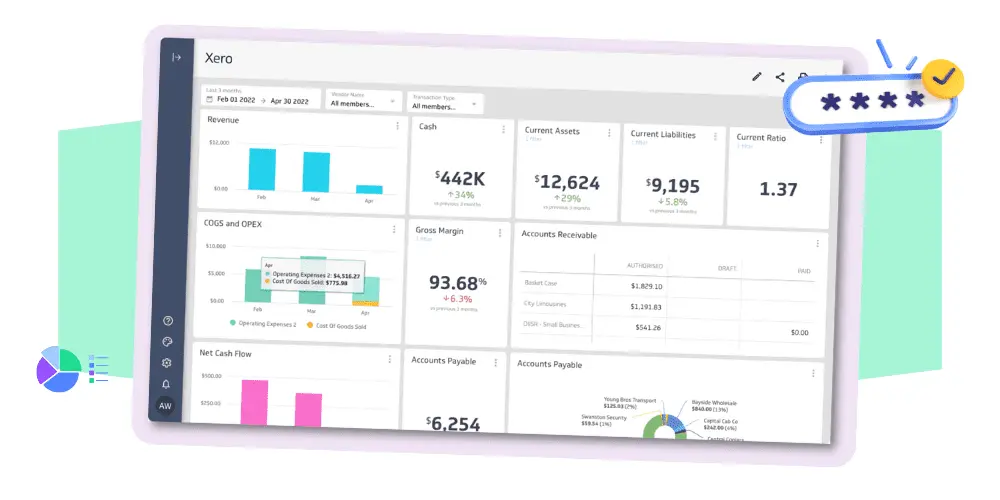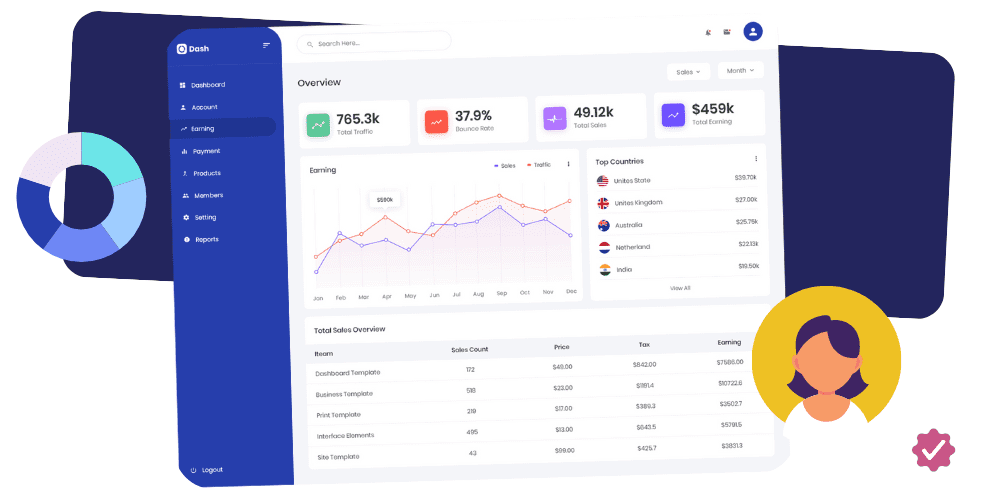Pro rata is a rather complex subject for many employers and employees. But, they have to calculate the right pro rata salary and holiday entitlements to avoid breaking the law and stop treating employees unfairly.
What Is Pro Rata?
Pro rata, which is a Latin word meaning “in proportion,” is used when giving something to people in equal parts according to their share of the total amount. It basically means that everyone gets their right share depending on the size and extent of the whole.
When you have to calculate parts of a whole, use the pro rata principle! It can be used in many different business areas, from charging for services and calculating interest to setting insurance benefits for part of a time.
As for paid holiday entitlement, pro rata pay is the right amount to compensate you at a fixed rate for a part of a bigger sum.
At work, pro rata makes sure part-time, fixed-term, casual, or workers on other such agreements get benefits that are right for the hours they work. This is not just for money but also holiday pay, bonuses, pensions, sick pay, and other worker rewards.
Some UK laws look after how well the pro rata rules are followed:
- The Equality Act 2010 stops part-time workers from being treated worse.
- The Part-Time Workers (Prevention of Less Favourable Treatment) Regulations 2000,
- The Working Time Regulations 1998, which secure that all statutory entitlements, e.g. holidays, are calculated fairly,
- Under the Employment Rights Act 1996, requires the details of pay, holidays and arrangements relating to pro rata are required to be included in the terms and conditions of employment contracts
calculation of pro rata is calculated in specific instances, e.g. maternity leaves, temporary contracts, and job-share provisions, where standard calculations are hard to apply
Benefits accruing to employees, as per the terms of the pension scheme but other than it, for example performance-related pay, annual leave, company sick pay, or perks such as gym membership or private health insurance should not be reduced on a random basis but in proportion to the hours worked or the length of the contract.
Pro Rata Calculations for Insurance and Dividends
The insurance sector uses the pro rata to calculate the premium if the policy is cancelled or starts having a mid-term effect. For example, a 12-month policy that costs £1,200 is cancelled after 3 months, then the unused portion, which is £900, will be refunded on a pro rata basis. This is only going to prove fair, so that customers are only going to pay for the coverage period they receive. Pro rata also provides for accurate risk pricing and policy adjustments, thus maintaining transparency and trust between the insurer and the policyholder.
Another rule of sharing out money with the owners of a company is the pro rata rule. When a firm says how much it will give as dividends, each owner gets a sum that matches their shares. For example, if a company gives £100,000 as dividends and a shareholder has 5% of all the shares, then they will get £5,000. This makes sure that every owner is paid back in line with how much they have put in.
Pro rata dividend distribution applies when shares are acquired or disposed of by the shareholders during the period. The dividend is adjusted with respect to the period for which the shares were held and the number of shares to reflect the true and just payment.
Curious how external factors like Brexit might impact dividend handling or VAT for contractors?
How To Work Out Pro Rata Salary?
Working part-time comes with the perk of earning an annual salary proportional to the hours worked. To determine this amount, divide your yearly pay by full-time hours and multiply it by how many hours you work. This will give you a figure reflective of what proportion of that fixed salary you can expect to receive in return for your time at work.
For example, if an occupation gives a yearly fee of £30,000 for full work time (40 hours a week), then part-time workers with 25 hours in a week would earn about £18,750 per year (£30,000 ÷ 40 x 25).
If a person joins your team either part-time or full-time in the middle of a financial year, the income has to be apportioned as per the period left. Also, if one starts in the centre of a month and is receiving a fixed salary each month, then one has to calculate the daily wage and pay for the number of days worked for that particular time.
How to Calculate Pro Rata Salary with a Formula

Pro-Rata Salary = (Annual Salary / Full-time Hours) × Actual Work Hours
OR
Hourly Rate = Annual Salary of Full-Time Employee / Total Hours in a Working Week
Pro-Rata Salary = Hourly Rate × Hours of Pro-Rata Worker
How can you accurately calculate pro rata holiday entitlement?
By utilising a pro rata basis when allocating annual holiday entitlement, it is essential to start with the contract of employment. Depending on its terms, an employee may be eligible for contractual leave. However, as stated by the Working Time Regulations 1998, almost every worker has a legal right to at least 5.6 weeks of paid vacation per year including bank holidays and public holidays.
Full-time team members regularly working five days per week are entitled to the maximum allowance of 28 days of holiday (five x 5.6). However, how much annual leave an individual receives will depend on more than just hours worked; other factors such as their arrangement and type of employment also play into it. Vacation entitlement can be calculated in a range of different ways depending on these elements.
Holiday entitlement for a part-time worker
Part-time workers are entitled to at least 5.6 weeks paid holiday like any other employee, which calculates out to fewer days than 28 when divided pro rata. Statutory leave for the year is determined by whichever number is less – either 28 days or 5.6 times how many days they worked each week in total throughout the full year regardless of if they work part-time or full-time hours.
If you are a part-time worker with regularly scheduled working hours and a fixed duration of your workday, then the most straightforward way to calculate your holiday is in days. To illustrate, if someone works 4 days per week, they are quite rightly entitled to 22.4 days’ leave each year (that’s 4 x 5.6). And for those who log three days weekly, their annual leave amounts to 16.8 days off from work (3 x 5.6).
It is essential to remember that the statutory holiday entitlement cannot exceed 28 days. Even if someone works more than 5 days a week, they will be capped at receiving the maximum amount of 28 days’ annual leave.
For those working varying hours each week, the rules of statutory leave can be a bit murky. However, calculating your entitlement to 28 days’ worth of vacation is still possible – simply multiply the number of days allowed by your average day’s length! That way, you will abide by the cap while also making sure that you receive all that you’re entitled to. This approach makes it easier than ever before to ensure accurate and fair calculations when allotting time off for yourself or others.
To calculate the average working day, simply divide the total hours worked per week by the days worked. Take, for instance, a part-time employee who works 30 hours in 4 days: Their average workday would be 7.5 hours (30 ÷ 4). This also determines their statutory leave entitlement of 22.4 days or 168 hours (22.4 x 7.5).
Holiday entitlement for a worker starting mid-way through a leave year
Regardless of whether a worker is part- or full-time, if they start working with you in the middle of your leave year, any annual paid leave entitlement must be prorated to represent the portion of time left. Based on their total 5.6-week entitlement, how much exactly that leaves them with relies upon both how many weeks remain and the number of hours they have worked for you during this period.
Upon commencement of employment, you have the option to utilise a ‘leave year’ system or an ‘accrual’ process—both will help to determine how much leave your team should receive. Typically, their designated leave year is stated in either their contract or other written documentation; however, if nothing is specified then it automatically begins on their first day at work.
Want to learn how missing certain entitlements could affect your long-term benefits?
Accrual System
Under the accrual system, employees can only take their leave as they’ve earned it throughout each month. They will earn an extra one-twelfth of their annual entitlement on the first day of every calendar month until all accrued leave is taken.
To illustrate, if an individual began their job on October 1st, 2020 – even when the leave year stated in the contract is January 1st to December 31st – they should have acquired a twelfth of their full annual leave entitlement. All employees begin to accumulate leave on their first day of employment–which means by the end of 2020. They would have earned three months or seven days’ worth of annual leave. This is calculated using a 28-day full entitlement (28 ÷ 12 x 3).
On the contrary, to discover a new employee’s statutory holiday entitlement for their leave year when starting mid-way through that period, we must take their total annual leave allowance and divide it based on how many months of service they commenced.
Take, for example, an employee who begins work on August 10th, 2020 and works full-time 5 days each week. This person would have a total annual leave entitlement of 28 days annually when using the calendar year (January 1st to December 31st, 2020) as the basis – accounting for five months they’d be employed by then. This would grant them a vacation allowance of 11.66 days (28 days x 5/12).
Round Your Holiday Leaves
Lastly, always remember to round your holiday leave entitlement up to the nearest half or whole day. Doing this will ensure you obtain 12 days of annual leave by year-end. It is essential to understand that rounding down is not an option – only upwards!
Because it is challenging to round up fixed hours worked each week in intervals of half or full days, calculating leave based on an average working day may be the more appropriate option. This way, workers are better able to understand their allotted vacation time and plan accordingly. When computing a worker’s full annual leave entitlement, you should first convert the number of days into hours by rounding it up to the nearest half or whole working day and then multiplying that value by an average working day. This calculation should be based on the months worked to prorate appropriately.
Holiday entitlement for a worker leaving mid-way through a leave year
If an employee departs before their leave year concludes, their holiday allowance will cover the span of time from when the leave year began until the end of employment, unless specified otherwise by a contractual agreement that allows for unused vacation days to roll over from prior years.
Upon the cessation of employment, employees have a right to receive remuneration for any outstanding statutory annual leave yet to be used up until that time. Nevertheless, an employee will only obtain compensation for any unexercised contractual holiday allowance when the employment contract explicitly allows it.
For the individuals that operate with regular hours and a predetermined working day, their unused holiday entitlement can be calculated by multiplying their yearly vacation allowance to the percentage of time they were employed during the year. Don’t forget to subtract any holidays already taken from this total!
For instance, an employee working five days a week full-time will have 28 vacation days annually. If that individual has been employed for 40% of the 365 leave year (146 out of 365) without using any vacation leave by their last day and they are dismissed, they would be eligible to receive payment in lieu of 11.2 total days off (28 x 40%).
When calculating the statutory cap of 28 days for workers with varying hours per day, but a fixed number of hours each week, it’s essential to convert this figure into actual working hours. To achieve this goal, simply multiply the remaining leave in days by their average daily work time.
Working on a Pro-Rata Basis
The Part-Time Workers Regulations guarantee that part-time employees will receive the same benefits as those who work full-time. This includes access to pension plans, which must be provided on a pro-rata basis according to current regulations. If you are in need of an online calculator for calculating holiday entitlement, look no further than gov.uk!

Advantages and Disadvantages Of Hiring Employees On a Pro-Rata Basis
Pro-rata offers a number of advantages to employers. Most notably, it allows them to recruit staff on an as-needed basis and offer flexible contracts that cater to their individual needs. On the other hand, pro-rata also has its drawbacks, such as the potential for misunderstandings or disputes surrounding what is due from both parties.
Outsourcing can be a great way to reduce payroll costs for small businesses. Here are some of the benefits it offers:
- By leveraging automation, businesses can save on payroll costs while simultaneously providing employees with flexible benefits during peak business periods.
- With robotic process automation in the workplace, companies are able to streamline their processes and reap a variety of cost-saving benefits.
- Outsourcing payroll services can provide businesses with more accurate and up-to-date information on their employees while reducing the burden of managing employee data.
- Working with a professional provider ensures that all legal requirements are met, saving employers from potential fines or violations.
Although there are multiple benefits, it’s also important to take into account the potential drawbacks:
- By lacking commitment, teams can suffer from a high turnover rate which makes it incredibly difficult to foster strong team building.
- Drastically high employee turnover rate
- Building a successful team can be a difficult feat, but when achieved, it yields great rewards.
- It is important to weigh the pros and cons before deciding what works best for your organisation when it comes to hiring employees on a pro-rata basis.
Conclusion
Pro rata is a method of calculating salary or holiday entitlement for employees who work part-time or on temporary contracts. Employers must ensure that part-time workers receive the same benefits as full-time staff in accordance with current regulations. When done correctly, pro rata can save businesses time and money while also offering their employees flexible working arrangements. However, it’s important to consider the potential drawbacks before committing and weigh up what works best for your organisation. If you need some help managing payroll, Clear House Accountants can offer comprehensive accounting services and payroll services that make workforce management easier!
With these tips in mind, employers can confidently manage part-time staff and ensure everyone receives what they are due.
Additional Resources
Frequently Asked Questions
What is Pro Rata?
Pro rata is a method of calculating salary or holiday entitlement for employees who work part-time or on temporary contracts. Employers must ensure that part-time workers receive the same benefits as full-time staff in accordance with current regulations.
How do you calculate Pro Rata salary?
To calculate pro rata salary, you must first determine the number of hours an employee works per week and their annual salary if they worked full-time. Then divide that annual amount by 52 to determine what they should earn each week. Finally, multiply this figure by the number of hours they work to find their pro rata salary.
What are the benefits of Pro Rata?
The main benefit is that it allows employers to provide flexible working arrangements for part-time staff while also saving time and money on payroll costs. It also enables businesses to comply with legal regulations by ensuring all employees receive the same benefits, regardless of their working hours.
What are the drawbacks of Pro Rata?
The main drawback is that part-time staff can experience a high turnover rate due to their lack of commitment. This makes it difficult to foster strong team building and can drastically increase employee turnover rates. Additionally, pro rata can lead to complexities when it comes to payroll management, which is why many employers choose to outsource the task.









































































